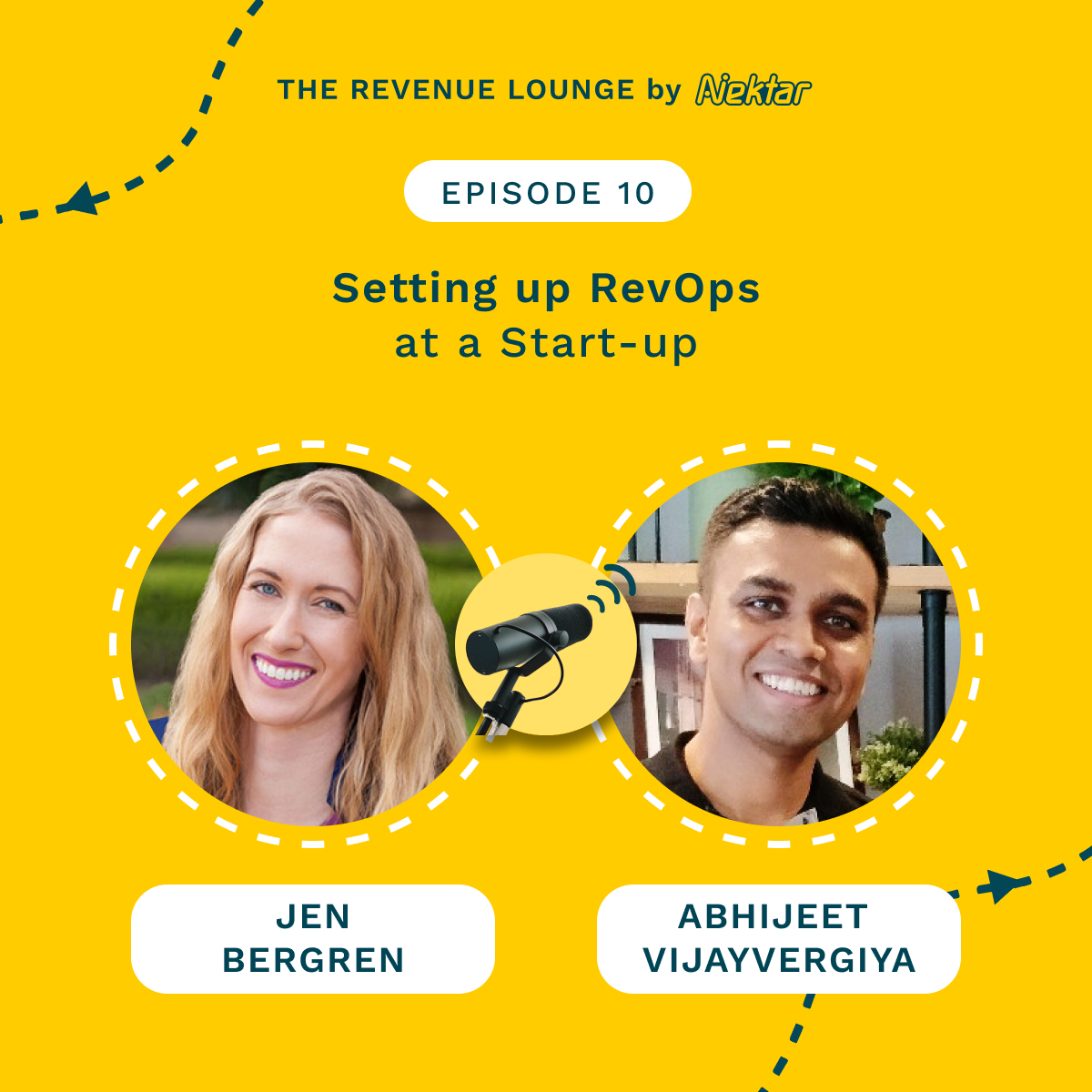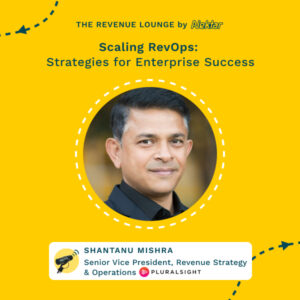Data-Driven Strategies to Prevent Customer Churn ft. Mahesh Motiramani
April 23, 2024
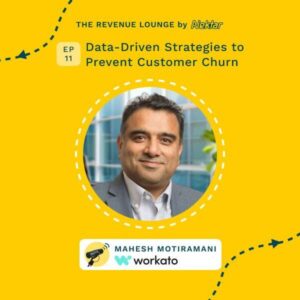
About
The Revenue Lounge
The podcast covers stories from leaders across RevOps, Sales, Customer Success, GTM, Data and Marketing about what drives these functions and what advice they would share with our listeners. With 3 seasons recorded, the podcast currently features 50+ enterprise leaders in the B2B SaaS domain. Tune in to hear from the best in the business
In this episode of the Revenue Lounge podcast, host Randy Likas interviews Mahesh Motiramani, the Regional Vice President of Enterprise Customer Success at Workato. They have an in-depth discussion around leveraging data to improve customer retention, identifying signals of customer churn risk, driving adoption and showing value. Listeners can expect to gain insights into proactive customer success strategies and real world examples of using automation and AI to deliver impact.
Guest Bios:
– Randy Lykas: Host of the Revenue Lounge podcast. Focused on customer retention and long term business success.
– Mahesh Motiramani: Regional Vice President of Enterprise Customer Success at Workato. Over 25 years of experience in go-to-market and revenue roles. Previously worked at MuleSoft, Salesforce and Dataiku building and scaling customer success teams.
Key Discussion Points:
– Importance of unified data for identifying churn signals and tracking customer health (5:28)
– Techniques to drive adoption of use cases and show value (9:11)
– Common reasons for customer churn and how to mitigate (11:06)
– Managing cross functional stakeholders from sales to renewal (16:22)
– The role of AI and automation in transforming customer success (24:26)
Key Quotes:
“It’s been extremely important to try to bring all of that external engagement data and the product engagement data together to understand these signals as to whether a customer’s onboarding was appropriate and they got enabled, whether that implementation is going well…” (5:28)
“I’ve had is is actually working in data companies…recognizing the importance of data in running the business. Right? So when it comes to the business of customer success, absolutely critical to get data along all the sort of milestones or waypoints in in a customer journey…” (4:23)
“The role AI probably, you know, took off about a year and a half ago with, chat GPT. And, unfortunately, a lot of people, you just know AI as ChatGPT, which is not the case. We’ve been using AI that’s embedded in our product for at least 10 years…” (24:42)

[00:00:05] Randy Likas: In an environment where competition is fierce and customer expectations constantly evolving, businesses must leverage data effectively to anticipate, address, and mitigate churn risk. Today, we will explore actionable techniques, real world examples, and expert insights to empower your organization with the tools needed to proactively retain customers and foster long term success. Hello, everyone. Welcome to another episode of the Revenue Lounge podcast. I am your host, Randy Lykis.
00:00:31 Interview with Mahesh Motryamani on Customer Success at Workato
[00:00:31] Randy Likas: And joining me today is Mahesh Motryamani. Mahesh is currently the regional vice president of enterprise customer success at Workato. He is a revenue focused customer success leader with a track record of building successful teams and hiring great people to drive business growth. Hi, Mahesh. Thanks so much for joining us today.
00:00:48 Discussion on Customer Success and Enterprise Automation at Workato
[00:00:48] Mahesh Motiramani: Thank you, Randy. Happy to be on this, podcast, Scott.
[00:00:51] Randy Likas: Glad to
[00:00:52] Randy Likas: I me as well. I’ve been looking forward to to speaking with you for quite some time. I I usually like to start these conversations and just I get a little bit of a feel for for who you are. So maybe you could talk to me to us a little bit about your background and what your role is at Workhollow today. Alright.
[00:01:05] Mahesh Motiramani: Yeah. I’m a go to market professional with over a decade of experience in just customer success besides a broader 25 year plus experience in go to market and revenue roles. And I’ve had the privilege of working for some awesome companies like MuleSoft, Salesforce, Dataiku, and and now at Workato where I had the privilege and pleasure of, building customer success organizations and scaling them. So I as I mentioned, I work for Workato now, and Workato is a leader in enterprise automation market and the only sort of cloud native SaaS offering for an enterprise grade orchestration platform where you can build AI driven workflow automation, data integration, API management, chatbots, and stuff. All the stuff that we need in customer success, by the way.
[00:01:51] Mahesh Motiramani: Yes. Absolutely. And both IT and non IT, non expert users can build all of these things 10 x faster with our no code, low code platform. And in fact, we are working, towards and and have some beta of some virtual customer success managers inside and outside the platform that actually help you generate automation ideas for your company and then take you along that journey, guide you really watching, over your shoulder, not in a creepy way, but in a in a guided way to get you to that outcome, which is so important today for the customers to get to value faster. And in in terms of my role at Workado, I’m part of our enterprise CSM organization, which is an offshoot of our broader and larger customer success org tasked with providing a differentiated experience to our largest and most strategic customers.
[00:02:42] Mahesh Motiramani: These companies are, I always say this with a word of caution in customer success where we really we have people from b to b large horizontal platform companies that I see. So I’m one of those. Work with very large companies, which where you go very horizontal working with various functions, various stakeholders, various use cases. So we work with the champions to drive that groundswell of adoption, and then we work with execs in in providing that consulting grade, service to help them craft this automation strategy or road map and then help them, get it going through professional services or or partners. And then finally, we are the quarterback of all the customer advocacy programs, bringing customers into advisory boards, networking opportunity, and and other events.
[00:03:32] Mahesh Motiramani: So that’s a little bit of my elite team of customer success managers.
00:03:52 Importance of Data in Customer Success
[00:03:52] Randy Likas: And Workato is an interesting company because you’re in the business of unlocking data. Right? Be that that’s typically locked up in a lot a lot of systems. And so I would just love to get your perspective in terms of, like, how important is having good accurate data for a customer success leader, and how might data help identify signals that’s gonna help you manage the the business better?
[00:04:11] Mahesh Motiramani: Yeah. Absolutely. The the privilege I’ve had is is actually working in data companies. Right? Data integration at Nilsoft, customer data Salesforce, and then data analytics and AI at Dataiku.
[00:04:23] Mahesh Motiramani: And so that was one of the reasons I ended up in those companies is recognizing the importance of data in running the business. Right? So when it comes to the business of customer success, absolutely critical to get data along all the sort of milestones or waypoints in in a customer journey that’s inside the product and the customer journey outside the product where they interact with your, you know, various channels, tools, support, marketing, and all of that, your events. So it’s been extremely important to try to bring all of that external engagement data and the product engagement data together to understand these signals as to whether a customer’s onboarding was, you know, appropriate and they got enabled, whether that implementation is going well, whether they are making progress with the work that they’re doing inside the platform, whether they’re making progress with the learning that is available to them and the quality of their work. All of these indicate, you know, whether they are marching towards that value.
[00:05:28] Mahesh Motiramani: And if they aren’t, those are the signals that we get. Like, this customer is a risk for a churn. In b to b large enterprise world, a big churn can take down your renewal way significantly. It’s not we’re not talking tens of thousands. We’re talking 6 figure, hits.
[00:05:44] Mahesh Motiramani: So it’s very important to look at customer level data signals and the user level data signals and bring those together to spot these risks of churn or opportunities of growth.
00:06:09 How a Customer Success Automation Platform Identifies and Implements Use Cases
[00:06:09] Mahesh Motiramani: Yeah. So we we don’t have an external, platform, and we haven’t felt the need to have that because we have a great data foundation Mhmm. Data lake where all of our engagement data, product data, accounts, invoices, everything about the customer and the industry is flowing in Yeah. Including benchmarks from third parties and all of that. So we are able to, first of all, build a a data centric view of the customer, 3 60 degree view of the customer, and and then we are an automation platform.
[00:06:40] Mahesh Motiramani: Right? We know how to get the data from one point to another. We know how to automate certain processes. And we are a low code, app platform. So every time we need playbook or process to be implemented, we have the ability to very quickly, using our platform, build an application that allows a customer success manager to execute that play and and give them an ecosystem of tools that are in house.
[00:07:09] Mahesh Motiramani: So that’s the direction we have gone in.
[00:07:11] Randy Likas: That I imagine that once you get into an organization, you probably start working with them to solve some first first level use cases that were identified as part of the sales process. But once you’re in there, there are several use cases that you’re able to unlock. And and and how do you go about that? Like, how do you identify what the best use cases are to help a a client, you know, solve?
[00:07:29] Mahesh Motiramani: Yeah. I think so. So it starts with your value prop. Right? You have to know what use cases, at least at a 3,000 foot level, 2,000 foot level, your product is capable of delivering.
[00:07:42] Mahesh Motiramani: Right? So what we have done is we’ve gone in 2 direction. There are there are standards in in consulting organizations who help customers with determining their automation strategy. Right? So we have understood each and every function in an organization, every line of business very deeply and identified a library of potential use cases.
[00:08:04] Mahesh Motiramani: So that’s 1. 2nd, we have, I I don’t know, maybe 250,000 or more use cases implemented in our platform. We can anonymize data. Mhmm. And and we can bring all of that together to tell you so let’s say you are, an HR director.
[00:08:21] Mahesh Motiramani: I don’t come to you generally to ask you, hey. What would you like to do with our platform? We lead with that prescriptive approach. We would tell you that, hey. First of all, let’s do an assessment of where you are, and then we can tell you what other people in your domain have done, what other industries, or what other companies in your peer group has done, and these are the opportunities available.
[00:08:43] Mahesh Motiramani: So I mentioned one of the knowledge parts of virtual success manager you’ve created. It’s a bot where you input certain information. It can actually give you, potential value of all the automations you could do or all the ways in which you can use our product Yeah. And what is the value and how should you go about prioritizing it. And then if you give us the information about what your tech stacks look like, we can actually start building those on the fly using a Copilot.
[00:09:11] Mahesh Motiramani: So we we are, like, creating this layer around the customer that provides the guidance to prioritize, that gives you recommendation on how to go about it, and that helps you actually build that particular use case and take it to value.
00:09:49 Challenges and Solutions in Customer Churn
[00:09:49] Mahesh Motiramani: Yeah. Absolutely. It is a KPI. So we are a consumption based platform. You buy certain set of capacity metrics, and we help you get those adopted.
[00:09:58] Mahesh Motiramani: So that’s the most foundational metric. Right? On on top of it, there is use case adoption metrics. So we are able to see we have internally created index called work automation index, which lists, like, in in this particular area, there are, let’s say, 200 opportunities to automate processes. You have done 5, so your score is 2.5.
[00:10:21] Mahesh Motiramani: So we’re able to benchmark you against our customer base as well. So while measuring this, we are able to not only inform ourselves to help customer move along, but we are also able to create this motivation and a guide for the customer to pick up more opportunities for adoption.
[00:10:39] Randy Likas: Yeah. Yeah. What what about churn right now? I think for if you’re a software company in the past 12 or 18 months, you’ve been dealing with churn for a number of different reasons. Right?
[00:10:46] Randy Likas: They’re what do you see as being some of the biggest challenges that customer organizations, face today in in in churn, and and how are they solving for that?
[00:10:55] Mahesh Motiramani: Yeah. I think it’s a big problem. Thankfully, we are quite sticky. What I see in that limited, world that we have, thankfully, is that what are the top three reasons of churn, for example? Right?
[00:11:06] Mahesh Motiramani: You have failed implementation or poor onboarding experience. Right? Number 2, people have started to build something, and they’ve fallen off. So there’s no value being created or value being articulated to the customer. And then number 3 is in this environment, no meaningful contact with the customer.
[00:11:23] Mahesh Motiramani: Why? Because of economic conditions. They moved. They were laid off or things of that nature. So while we do tend to blame, or or make these excuses of economic situation, I’ve seen that it has mostly led to downgrades rather than a full churn because if an organization is partially using, the product is sticky enough to not get canceled completely.
[00:11:47] Mahesh Motiramani: So we we focus on what’s in our control. Right? So those three biggest reasons thankfully happen to be in our control. Now in in terms of being able to control, you need data around all of that. You need data around how your implementation is going.
[00:12:03] Mahesh Motiramani: Yeah. How did your onboarding go? What was the customer’s experience? And then what value have you started to create? And then in terms of contact, what is the customer engagement looking like?
00:12:28 Challenges in Customer Onboarding Process
[00:12:28] Mahesh Motiramani: So we’re not really careful in that initial journey. It’s like a newborn baby. Right? You gotta be extremely careful in that phase where they have no wherewithal to take care of themselves. We gotta help them progress through that, newborn stage.
[00:12:43] Randy Likas: Yeah. So what would be an example of, some of those data based signals that you might pick up on to help any one of those 3 mention you mentioned, like, failed implementation, starting to build, and then falling off or just no meaningful contact. What are some of the early data signals that that you might see to go, uh-oh. This might be a problem. Can you talk a little more about that?
00:13:17 Measuring Success and Engagement in Customer Relationships
[00:13:17] Mahesh Motiramani: So it’s a smart sheet that has all of those milestones that are automatically populated and tracked. So first of all, are you on track, off track with respect to just being on that schedule? So is your implementation going well? Right? The health of implementation.
[00:13:33] Mahesh Motiramani: And then there is, in terms of learning and engagement, we have these early indicators because we know that if a customer has, for example, made a purchase of $200,000, they need at least 8 developers or 8 builders to be working on this product to adopt it to 80 to 90% come renewal year. So did we identify 8 or 9 people? Did they undergo training in that 8 week period, or is there a plan? So that sort of tells us the adoption health. And then at that mark, we look at, you know, the first value period.
[00:14:10] Mahesh Motiramani: So first value is a big milestone for us. We must achieve meaningful first value in the 1st 8 weeks. And so that if that doesn’t happen, it it triggers all sorts of flags and warnings both to us and to the customer where we say, hey. We told you we’d let you know if you’re off track. Yeah.
[00:14:28] Mahesh Motiramani: Here, we are trending towards off track, and we need your help. So those are some of the things that we measure. Exiting that, like, one of the things is that some metrics you can measure, but you’re too late to change the behavior. So at 8 weeks, if you’re measuring the number of projects started, you’re probably a little bit behind.
[00:14:48] Mahesh Motiramani: also tracking what is the build activity going on in the platform. Is that in line with our benchmark of, let’s say, top 25 quartile customers?
[00:14:57] Randy Likas: Yeah. And is all that data that you’re looking at built within your platform, or is there external data sources that you’re looking at to help bring bring all these these insights together?
[00:15:06] Mahesh Motiramani: Yes. Without taking names of the vendors, we have telemetry in the product itself Yeah. And all of these LMS and community support systems that they have, we bring all of that data into a centralized cloud data low lake that’s by a very famous, company in that space. And they’re also a leader in consumption based sort of models. And then on top of that, we have built a layer of dashboards and automations and tracking capabilities to monitor, manage, and alert on on changes in customers’ health and progress.
[00:15:44] Randy Likas: Yeah. Question for you on let’s dig a little bit deeper on the, you know, the amount of people who are involved. And what we’ve seen often is, you know, you think about buying groups these days. And and when you’re making a first initial sale, all the people that that are coming on in and out of a deal to help make that initial sale. Sale.
[00:15:59] Randy Likas: Once that sale is made, it’s often a different set of stakeholders who are now getting involved. Maybe some of the people are are the same, but it’s a but it’s a different group as as well. And so you think about, like, the buying committee versus the renewal committee and the IT folks and the business folks. How do you look at the the renewal committee, if you will, or the engagement of the individual individuals on an account that you need to have on an ongoing basis?
[00:16:22] Mahesh Motiramani: Yeah. I think critical customer success manager role is being that bridge between buyer and the end user of the software. Right? Which means you have to have that two way communications. Almost they don’t talk to each other.
[00:16:35] Mahesh Motiramani: They get or they’re reporting or communication structure in some other language. Right? So we we have these operational reviews and these, business reviews where we constantly bring to the users this focus and reminder of, hey. Why did your organization buy this? Often, for example, we are brought in to transform, let’s say, HR capability.
[00:16:58] Mahesh Motiramani: Right? But the end user that my CSM ends up working with on his or her plate, they’ve got this project which says, I wanna just connect Salesforce to whatever Workday so that I can transmit the commission data and and pay these individuals. Right? So they are not thinking automation.
[00:17:17] Mahesh Motiramani: big job for customer success manager has been, besides being building that bridge, is to really change the mindset of the customers to go beyond the here and now and think of a larger term. And then we call it in fact, our CEO wrote a book on it. It’s called the new automation mindset. So we are saying, yes. You have to do those bits and pieces, but approach those with a sense of that broader perspective Mhmm.
[00:17:45] Mahesh Motiramani: And see what does organization need from a transformation perspective. So don’t build in silos. Right? And and then we we take the same sort of challenge to the executives and help them transmit help them understand that. Yeah.
[00:18:01] Mahesh Motiramani: Get their sponsorship and help them relay the same message back to the using group as to how they should proceed on this automation journey. This is something that we have to do constantly so that by the time you’re getting to renewal, there’s really no daylight between the the buyer group and the user group. They’re they’re all aligned, because they’ve been constantly listening to this message through our biweekly, monthly, or quarterly business reviews. Right? That’s we we we we bridge that gap, essentially.
00:19:00 Strategies to Secure Renewals and Relevance in Customer Meetings
[00:19:00] Mahesh Motiramani: Yeah. I look. Number one reason people don’t show up for meetings because they fear it’s going to be all about you, the vendor. Mhmm. And number 2, they have no idea and they have no interest in looking at the presentation deck or a video, which is, again, all about the vendor, doesn’t talk about their organization.
[00:19:17] Mahesh Motiramani: So establishing relevance. We train our CSMs and they’re very experienced people. What I mean is when we train, we come out with the message that is for the customer. When we schedule these messages, we are very clear about what we want to share with the customer and what we want to hear from them. It’s about them.
[00:19:37] Mahesh Motiramani: It’s about the results they’re getting. Now sometimes you have to send them a little preview of your meeting and really give them an option that, hey. I’m scheduling this meeting, but I can send you this information ahead of time so that we can skip some of this information that may not be of interest to you. And we can actually redo our agenda. Many times, they take up on that and say, yeah.
[00:20:02] Mahesh Motiramani: I wanna talk about x and y instead. Or sometimes they would say, oh, fantastic. They’re getting this much value. And the other thing that we do is in our QBR decks as an example, the previews that we send, we say, this is what you’re achieving with our platform, and this is what you are yet to achieve that your other peers, counterparts in your organization others are achieving. So we’d like to, use this call to get you to focus on this as well so that you can get more value from our platform.
[00:20:32] Mahesh Motiramani: And, by the way, renewal is coming up. We’re gonna take a look at that in the light of your current experience and value as well as future road map. So renewal then just becomes like an opportunity to expand that relationship. Right? To go deep, to go wide, and and get maybe sponsorship for more use cases.
[00:20:53] Randy Likas: Yeah. Yeah.
[00:20:54] Mahesh Motiramani: Because I’ve seen in the meetings with that that I’ve been with the CIOs and VPs of IT in different organization of business. And when you show them this current value and the value potential, the immediate thought is to their team. Hey. Why aren’t we using this product for this initiative? Right?
[00:21:10] Mahesh Motiramani: Yeah. So they start asking all of these questions which are, again, very valuable for us to expand that relationship.
[00:21:17] Randy Likas: Yeah. I’m gonna throw you a little bit of a curveball here. Let’s say we’ve got an account that’s going really well. We’re driving use cases. We think it’s looking very good for renewal.
[00:21:26] Randy Likas: We’re maybe 4 months out, and our champion leaves. What’s the what’s the cadence or the process that you that y’all follow to to make sure that you’re able to either find new champions or secure that renew that that renewal in that environment? What so what what advice or guidance would you give a listener who’s maybe had that experience?
[00:21:43] Mahesh Motiramani: You know, first of all, that’s a very concerning situation that, you know, that we have faced so many times in our career. So the obvious advice there is, number 1, get your customer to the value. So the new champion comes in, you’re able to play back that value and hope to secure the same relationship with that new, person who’s in charge. Right? Number 2 is multithreading.
[00:22:07] Mahesh Motiramani: Right? And with with a product like ours, and I’m sure there are many products out there that are not one trick ponies, those tough situation for them. But if you have a product that kinda lives in different organizations or different under the command of different executives
[00:22:23] Randy Likas: Yeah. I
[00:22:24] Mahesh Motiramani: I think overcoming that hesitation to have multithreading. Sometimes you’re afraid. If I go have this other relationship with another executive parallel to this champion, it’s gonna spoil my relationship with this one. It happens, but you gotta take your chances. You have to have that courage to figure out that right balance and have that multithreading relationship in in the organization.
[00:22:48] Mahesh Motiramani: But I would say that nothing beats value and adoption. If your product adoption is 80% or more come renewal, if you have multithreading, it’s fantastic. Even in very crazy scenarios. We have a a bad experience with the customer where they laid off about 20% of their staff, including the people who were working with us. So imagine no owner of the product itself, no users of many users of product were impacted.
[00:23:21] Mahesh Motiramani: And the gentleman who got the keys of the platform handed over to them, we went to them with the trends and the usage, and we immediately won that person over. And this is when there’s a turmoil. They wanna cut budgets 30, 40% of their IT budgets, cutting staffing budgets, and we were able to retain all of the revenue around the products they were using. Now there were small skew or something which they never used. They were not in the position to use.
[00:23:52] Mahesh Motiramani: We took that off of the contract and and traded that with the commodity that they were using. Yeah. So you you you lead with value, you lead with adoption, and you can create new champions using that data.
00:24:26 The Role of AI in Customer Success
[00:24:26] Randy Likas: Can’t read the paper or read an article online that that talks about that. It doesn’t talk about that. I’m curious, like what use cases that’s bringing to to customer success, whether you’ve been to implement them today or you just see them the, how they might work. Just what’s your what do you think the role is of AI in the future for customer success?
[00:24:42] Mahesh Motiramani: Yeah. I think the notion of AI probably, you know, took off about a year and a half ago with, chat GPT. And, unfortunately, a lot of people, you just know AI as ChatGPT, which is not the case. We’ve been using AI that’s embedded in our product for at least 10 years, And it’s a different sort of AI, different types of machine learning models. Yeah.
[00:25:07] Mahesh Motiramani: So where we have, you know, landed and landed is not a it’s not a place where we live forever. We continue to make progress. It’s 2 places. Right? 1, you have these statistical models that consume a lot of customer behavior data, product usage data to be able to help us pinpoint the opportunities, the problems, prediction, forecast deals, forecast customer churn or or customer usage.
[00:25:36] Mahesh Motiramani: Right? And providing those driving those recommendations on what should be the next steps for people who are closer to that particular problem. Right? So that’s internally. And then with the arrival of large language models, we’ve taken some of that on and implemented some knowledge related tools.
[00:25:53] Mahesh Motiramani: So I talked about this knowledge board called Walnut IQ, which is really a consultant, a virtual free consultant. You’d go to the likes of the big name consulting firms and pay 100 of 1,000 of dollars to get your automation road map created. But you can come to our knowledge bot and start interacting with it like you’re interacting with a consultant. You tell it what is priority for you, what do you want to achieve, and it’s gonna start laying out. Okay.
[00:26:22] Mahesh Motiramani: Randy, you’re in finance. Here are five towers of automation. Highest value here. Let’s pick a a particular area. In this area, what kind of use cases to build?
[00:26:34] Mahesh Motiramani: So this is that brain, the virtual CSM running in the background telling you what to do next, right, and what to pick. Mhmm. And then on once you have landed on a use case, then the AI, Copilot is basically natural language processing engine think combination of Clippy and coding Copilot. Yeah. You’re saying, hey.
[00:26:56] Mahesh Motiramani: I would like to do x. I would like to bring this data from Salesforce when an opportunity is closed. I want to create an opportunity in NetSuite. And once that is created, I wanna mark that as 1 and then I wanna generate an invoice and send it to the customer through this particular system. So you aggregated what systems, what connections, and what actions to be taken.
[00:27:23] Mahesh Motiramani: You told that to the bot. It’s gonna build that for you on the fly.
[00:27:28] Randy Likas: Wow. Now how time do you think so so go back 5 years ago, how long would it have taken to do that compared to using the bot today?
[00:27:36] Mahesh Motiramani: Yeah. It’s at least 3 to 4 weeks of work
[00:27:40] Mahesh Motiramani: That the bots have the copilots have reduced to a few minutes. Now I’m not saying people get very uncomfortable where they take an AI generated solution and put it in in production. So we’ve we’ve gone one step further. Right? We have AI that creates this automation, but at the same time, another capability that creates a test automation, which can actually test this.
[00:28:05] Mahesh Motiramani: And you have control in your hands where you can say, hey. I I don’t trust this. I wanna inject my own test. I wanna make it fail, or I wanna test it. It at every place, there’s there’s this AI.
[00:28:16] Mahesh Motiramani: Now the next sort of evolution for us is actually optimizing what customer is building with the product. Mhmm. So we don’t it’s a consumer platform. Right? You can burn any number of credits.
[00:28:32] Mahesh Motiramani: We don’t want you to waste your dollars on doing something meaningless. Right? Yeah. Even though it’s a valuable use case, you can implement it in an optimized manner. So we want to be running a Clippy assistant that’s gonna tell you, hey, Randy.
[00:28:47] Mahesh Motiramani: If you change logic here, it’s gonna improve the performance of your application. It’s gonna make this consume less resources. So, really, looking at value, volume, and velocity Mhmm. Those are the three things that aggregate we measure and drive towards improving inside the platform.
00:29:32 Capacity Planning Metrics for Customer Success Managers in Enterprise Space
[00:29:32] Randy Likas: Is it best to look at ARR under management? I guess, in the enterprise space as you’re looking to expand, it’s, like, potential ARR, number of accounts. We’d love to hear and I don’t wanna get too specific necessarily on Workato, but in your experience, like, when you think about the about capacity planning for CSMs, what are some of the metrics or guidance that you would recommend people to look at?
[00:29:53] Mahesh Motiramani: Look. I I think ARR and segment are pretty popular and pretty accurate in terms of providing that guidance up to a certain stage. Right?
[00:30:04] Mahesh Motiramani: A more sophisticated way that I’ve started to explore now is around unit economics. Right? So let us say in order to you you have a 6 figure for for argument’s sake, let’s say, $500,000 worth of contract. And you know that in order to get that $500,000 renewal, the customer success man the customer will have to build x number of projects to create enough value to get that renewal. Right?
[00:30:34] Mahesh Motiramani: Mhmm. So x number of prod projects, I will, as a CSM, need to support with or without digital tools. Right? So let’s cut out digital tools for the moment. Mhmm.
[00:30:46] Mahesh Motiramani: And that requires 4 departments and 50 users to be enabled.
[00:30:52] Randy Likas: Mhmm.
[00:30:53] Mahesh Motiramani: So you can look at that unit economics and and say that for every unit, I have to expend x number of hours. And in $500,000 contract, there is 200 units of effort. So you can look at that perspective and say variety of use cases that we do. So it’s very important to know what creates value for the customer. Mhmm.
[00:31:21] Mahesh Motiramani: And their because that’s what drives a customer success manager’s day by day play to get customer to that specific value. So if you’re able to do that from a use case point of view and then unit economics point of view, you can say a CSM has enough time to support 600 units.
[00:31:40] Randy Likas: Mhmm.
[00:31:41] Mahesh Motiramani: And so when I look at my book of business, I have to bring in enough accounts that roughly equate to anywhere between 708100 units of use cases or work for the CSF. Right? So that’s a more sophisticated way. It requires a lot of data. Yeah.
[00:31:59] Mahesh Motiramani: But if you don’t have a lot of data, I think segmentation and then I suppose there will be a stage where we will have little bit of that vertical focus. Right? Mhmm. So we bring in domain experience. Someone with HR is gonna have HR accounts of a certain spend, and then you hire according to that particular segmentation.
[00:32:21] Mahesh Motiramani: Right? So it’s a model that you have to keep iterating. You have to keep pushing people up to a certain domain knowledge level besides capacity consideration.
[00:32:33] Randy Likas: Yeah.
[00:32:34] Mahesh Motiramani: And then you have to constantly iterate on how do you carve these segments and map. So it’s an interesting exercise every year from November to February where we review this data and redo the portfolios of our customer customer success managers.
[00:32:49] Randy Likas: Yeah. No. I I like that the unit economics approach. I think that’s really to your point, it it requires a lot of data, so you have to have the data, but I think it’s a it it’s the right model. What are some of the I assume you you have you you may have some open positions right now.
00:34:47 Discussion with Mahesh Motiramani on Customer Success Strategies
[00:34:47] Randy Likas: So what’s one book maybe that you’ve they’ve read and and loved, in the recent past?
[00:34:51] Mahesh Motiramani: Oh, it’s right here on my deck desk here, and I’ve given it to all my CSMs. I shared it in all my interviews. A book called Impact Players by Liz Wiseman. It’s an amazing book with a framework to elevate people from being contributors to impact players. Right?
[00:35:09] Mahesh Motiramani: Contributors will do what we define for them as their role, which is great. Right? We want people to contribute well. Impact player is a player who gets does things that need to get done, what not not what they’re told
[00:35:25] Mahesh Motiramani: To do. So you’re operating at really a a higher plane, so to say. And that book gives you a framework for doing that. It’s not just the stories, motive motivational self help book, but really a framework of how to be an impact player. And every one of my team members has read it, discuss it as a team, and we try to operate as impact players.
[00:35:49] Randy Likas: I’ve written it down, and I’m I’m adding it to my list. What what’s the, what’s your favorite part about working in customer success?
[00:35:55] Mahesh Motiramani: Look. To hear about a customer success story, like how they change something, is what makes you happy. It makes makes for boring dinnertime conversations with the family. Like, I I can’t expect a reaction from my wife or son when I tell them, oh, this customer used to take a month in onboarding new employees. Now they can do this in 13 minutes.
[00:36:15] Mahesh Motiramani: Can you believe that? And and they’re like, yep. But if you look at lived experience of the users 5, 7, 10 years ago when I got onboarded to an organization, it’s pain to do all of these things manually. So when you think of, hey. This is what I’ve impacted or there there are several examples with literally you change people’s lives where they are not doing mundane activities anymore.
[00:36:38] Randy Likas: Right.
[00:36:39] Mahesh Motiramani: They they’re focused, their focus has shifted on doing valuable activities because an automation takes care of that mundane activity. And so that end customer value and and their story of impact on their lives and their customers’ lives is Yeah. Really the fun part in CS.
[00:36:56] Randy Likas: Yeah. I I agree. What about what your least favorite part is? Or maybe ask a different way. Like, what’s really hard about your job?
[00:37:04] Mahesh Motiramani: Yeah. I think my least favorite part I would say is is myself being patient. The change even though the world around us is changing very rapidly, our ability to change ourselves, our systems, processes, or people behavior skills, all of that is really slow. So we have to learn to be patient in operating at those 2 speeds, speed of the customer and speed of your own organization or or the team. Not saying my organization is slow, but my priorities are not their priorities.
[00:37:36] Mahesh Motiramani: Right? Mhmm. So you have to be very patient and align those priorities. And that’s the being patient is, I think, my least favorite part because I wanna move fast.
[00:37:46] Randy Likas: We we share that together the same way. Any advice that you’ve received from someone that’s really stayed with you throughout your career that maybe you’d like to share with everyone?
[00:37:55] Mahesh Motiramani: My my go to is really the serenity play, prayer. It’s not somebody’s, advice somebody living at least. It’s pretty old, what, 300 years old now. Yeah. The the serenity to accept the things that I cannot change and to have the courage to change the things I can
[00:38:13] Mahesh Motiramani: And and the wisdom to know the difference. Right? So that I’m not getting frustrated, wasting energy, or losing opportunities to change things. So that’s something is front and center. It’s printed out right here in front of me behind this, computer.
[00:38:27] Randy Likas: Yep. Okay. Last one. What’s what’s one piece of advice that maybe you’d wanna give someone who would like to have your job someday? Maybe just starting out in the customer success, and what would be the one piece what one that you’d you’d give them to to think about throughout their career?
[00:38:40] Mahesh Motiramani: Yeah. I know. I’ll probably get a lot of hate mail for saying this, but I practice it and my team does. So I’m gonna say it out loud. Start doing the the actual job that you desire.
[00:38:51] Mahesh Motiramani: Right? So it starts with learning, not just yearning to get that job, but learn what that job entails and ask for opportunities to do parts of that job yourselves. And and so when it’s time to find my replacement, the leadership clearly sees that, oh, so and so on, Mahesh’s team already does that.
[00:39:12] Mahesh Motiramani: Right? So as an example, I go to these weekly reviews with my sales counterparts, these regional leaders. And if you are a lead CSM on my team and you wanna pick up that responsibility for your own region to do that weekly analysis and and prepare agenda and go to this meeting and actually lead it Yeah. You are doing my job. You are already doing the RVP job.
[00:39:35] Mahesh Motiramani: So Yeah. When we grow and that position becomes available, you you make yourself the most likely go to person for that role. So start doing the job that you desire in future.
[00:39:47] Randy Likas: Become an impact player. Right?
[00:39:49] Mahesh Motiramani: Become an impact player. Absolutely.
[00:39:51] Randy Likas: With that, that’s a wrap for today’s episode. Mahesh, I just wanna say thank you so much for joining us. I thoroughly enjoyed our conversation. I learned a lot, and I look forward to maybe meeting you sometime in New York in the future.
[00:40:02] Mahesh Motiramani: Yeah. Absolutely, Randy. It was a pleasure, wonderful conversation. So thank you very much for inviting me to this podcast, and I hope that your listeners enjoy this and then get some value out of this.
[00:40:13] Randy Likas: I’m sure they will. Alright. Thank you.

Ep #1: Navigating the Downturn with a Hyperfocus on Productivity
Listen Now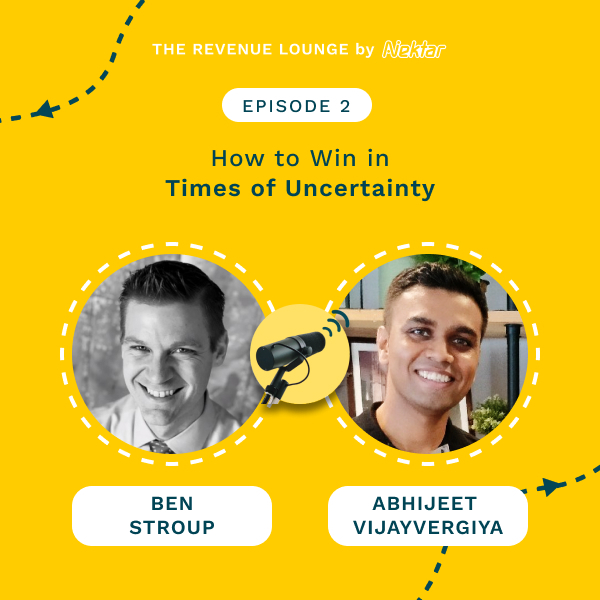
Ep #2: How to Win in Times of Uncertainty
Listen Now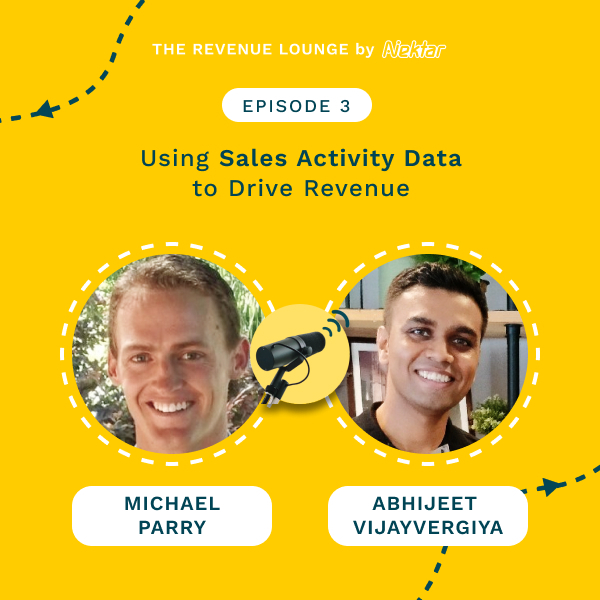
Ep #3: Using Activity Data to Drive Sales Productivity
Listen Now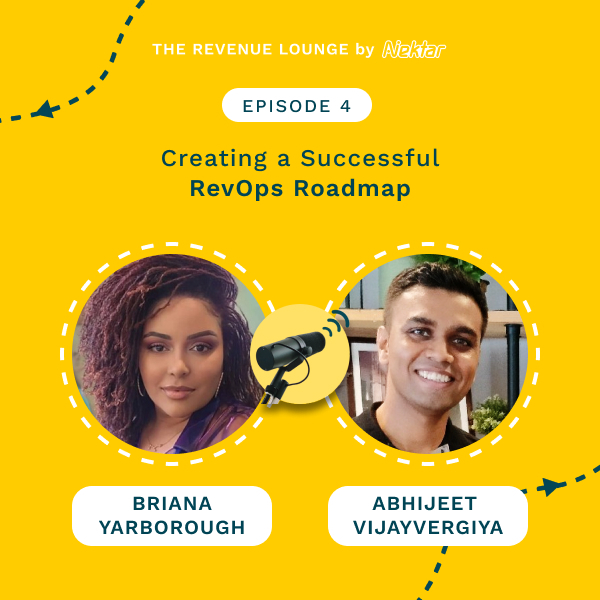
Ep #4: Creating a Successful RevOps Roadmap
Listen Now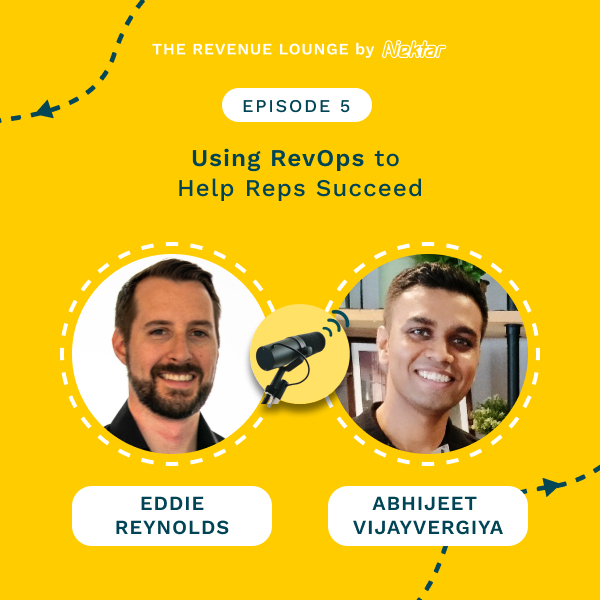
Ep #5: Using RevOps to Help Reps Succeed
Listen Now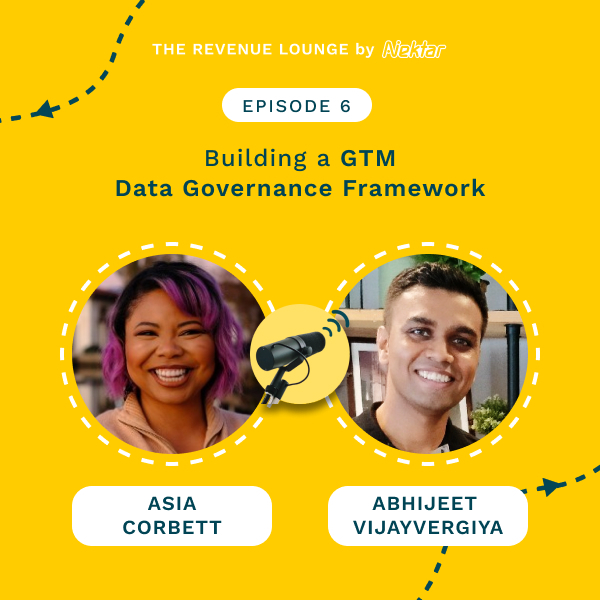
Ep #6: Building a GTM Data Governance Framework
Listen Now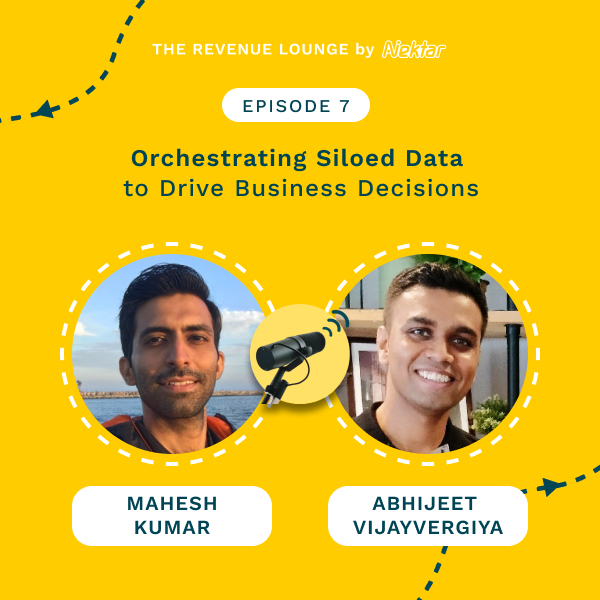
Ep #7: Orchestrating Siloed Data to Drive Business Decisions
Listen Now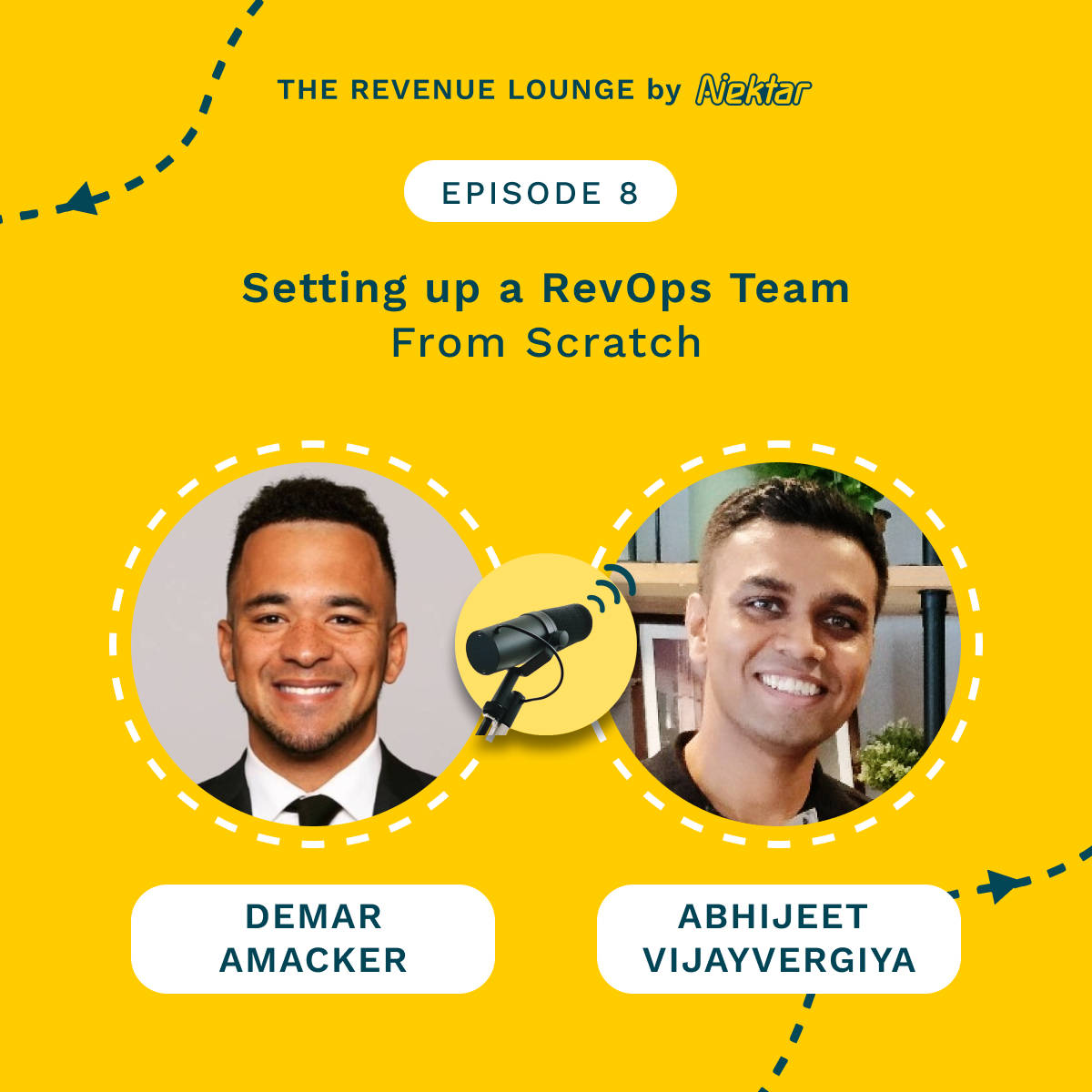
Ep #8: Setting Up a RevOps Team From Scratch
Listen Now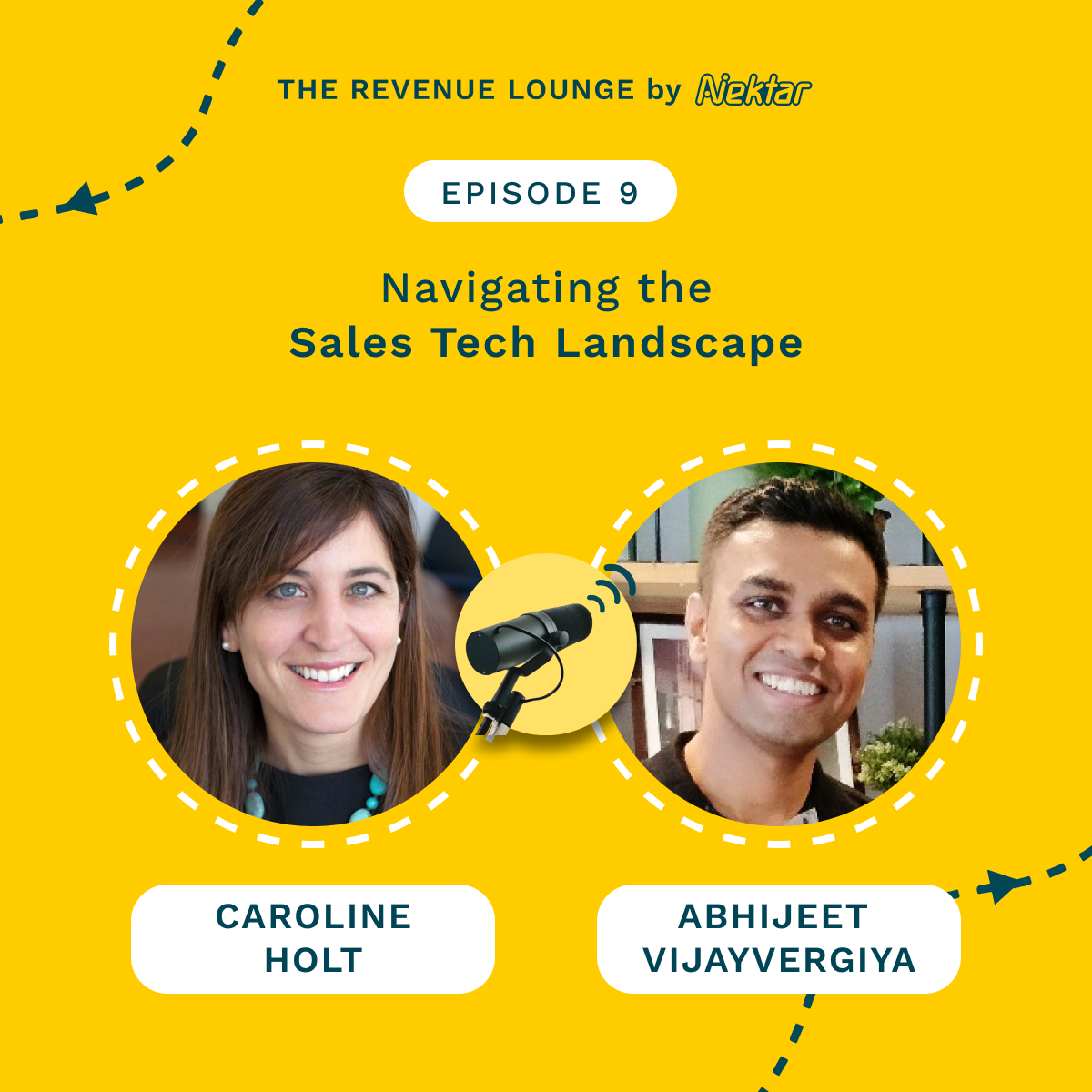
Ep #9: Navigating the Sales Tech Landscape
Listen Now